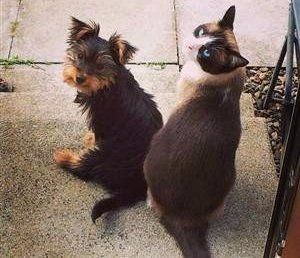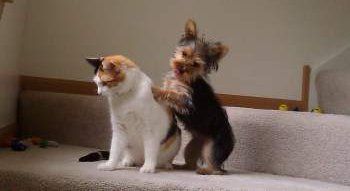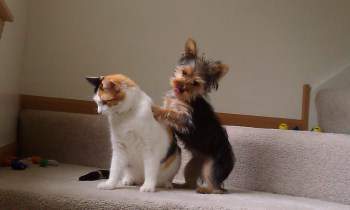Yorkshire Terriers and Cats
Chloe, 2 years old; Photo courtesy of Laurel
Overview
You may be wondering if mixing a Yorkie and a cat is a good idea. Do these two get along?
Will a Yorkshire Terrier chase the cat... or will the cat bother the Yorkie?
You may be hoping for a situation in which they become best friends, but is this always the case?
It's a good idea to find out how Yorkshire Terriers and cats generally get along before you make the decision to have both under the same roof.
Please note:
YorkieInfoCenter is reader-supported, and some of the product suggestions on this page are affiliate links. As an Amazon Associate we earn from qualifying purchases. This is at no extra cost to you and helps us continue providing free, high-quality information.
Things to Know About Yorkies and Cats
While both canines and felines will have their own distinct personalities, there are some general guidelines to know and some elements to keep in mind, should you want to have both a cat and a Yorkie living together in the same house:
- Size is a plus. Unlike quite a few other dog breeds, many Yorkshire Terriers will be relatively the same size or just slightly smaller than many cats (Yorkies are typically 3 to 7 lbs. though some are larger and the typical house cat is 7.9 – 9.9 lbs.)
This is a plus, that can lead to both of them getting along nicely. In some cases, however, the cat will grow to be larger than the Yorkie.
This is not often a problem if the two are introduced when young and have developed a bond well before the cat grows to be larger than the dog.
- There is not an overly strong chase instinct. Though the Yorkshire Terrier breed was bred over time to be a 'ratter', essentially chasing down and snaring small rodents (and therefore has the instinct to hunt and capture), this does not often carry over when it comes to cats.
Tilly, at 1 year old
Photo courtesy of Stephanie Thorley
Of course, if you have a larger-than-average Yorkie and place him in the same room with a very tiny kitten, this may not be the best idea. However, in general, there is not a strong instinct to chase cats other than the basic dog-to-cat relationship that naturally exists.
Tips for Having Both a Yorkie and a Cat
1) You'll want to evaluate each animal before mixing the two. If you are looking to bring a cat into the home, think about your Yorkie's history in regard to cats. If he has not had much exposure to cats, now is the time to have short sessions with your neighbor's, friend's or family member's cat(s) to see how your dog responds. Never push the interaction and do supervise. You'll just want to see what his natural instinct is. Do know that in time, it can improve.
Pat Fratangelo's rescued Yorkie, Nacho with the cat Snickers snoozing in Pat's lap.
If you currently have a cat and are thinking about getting a Yorkshire puppy, you'll want to assess how your cat does with other dogs. It is best if you can see how she responds to small toy breeds and of course, it is best if the dogs that you are introducing her to are known for being good with cats.
2) If you are planning on getting a cat from a shelter, do ask about her history. The shelter may already have written notes concerning what type of home would be best and if she was already accustomed to dogs.
3) Plan for a slow introduction.
It's never a good idea to 'get things over with'. Even if both animals have a history of tolerance, they have not yet proven anything in regard to each other. If a cat is coming into a Yorkie's home, it is best to place the dog in another room (do not make it seem like any sort of punishment, have someone stay with him if possible to entertain and keep him busy) and allow the cat to explore the rest of the house, picking up on scents and getting a basic vibe.
If a Yorkie is coming into a cat's home, keep her out of the way while he learns about the house and gains his bearings.
After 20 minutes or so, each animal will be aware of the other, even if they do not see each other. With the Yorkie on harness and leash and the cat given a route to scamper off if she wished, introduce the two.
4) Signs and signals.
A clear tolerance, of course, is best. However, essentially ignoring each other is also not a bad sign; this simply means that neither sees the other as a threat.
It takes 2 to 3 weeks to truly know how any one cat and any certain dog will get along. Until this time, keep all interactions supervised and whenever you are away from home, the animals should be separated. This time away from each other is actually a good thing, as it leads to short sessions in each other's presence and that is really the best way to give them enough time to get used to the idea that they will be living in the same household.
5) Both animals should have their own private spaces.
It may very well turn out that your Yorkie and your cat become best friends, always wanting to be near each other and even sleeping
together. However, at all times, each should have their own spot to retreat to, should they wish to have some space.
In regard to food, you'll want to make sure that your Yorkie does not eat the cat's food. Most cat food contains a much higher percentage of protein and different levels of fat than dog food and for this reason, many dogs are attracted to it. While eating a little bit is not reason for concern, long-term consumption of a such a high-fat food can cause all sorts of issues including diarrhea,
upset stomach and take a toll on the liver and kidneys.
Abby (Yorkie) with Hope (cat) | Owner: Darla Cook
Beware of a Yorkie getting into a cat's catnip.
While catnip acts as a stimulant to felines, it has the opposite affect with dogs. If a puppy or dog ingests catnip, it can acts as a sedative. It can also cause him to lose water, as it acts as a diuretic and finally, it can cause moderate to severe stomach upset.
With the litter box, you will also want to be sure to keep this out of the Yorkie's reach. If given the chance, many dogs will ingest cat feces and this can be decidedly dangerous. If a dog eats cat poop, he can catch worms (If a cat has worms or is shedding worms and eggs) and there are 3 main disease-causing bacteria found in cat poop that can make dogs sick: clostridia, salmonella and campylobacter.
One way to avoid this happening, is to place the litter box where a Yorkie simply cannot reach it. The top of the washer/dryer is often a popular choice.
If Your Yorkie and Your Cat Do Not Get Along
Serious problems - After the initial 2 to 3 week phase in which the animals are gradually getting accustomed to each other, if there are serious issues of chasing and fighting and certainly if either receives any injuries, this is a huge red flag that the two will not get along.
While most Yorkies do great with cats, there are always going to be some instances where it just does not work out. Of course, it is best if you go plan for this rare but possible circumstances in which the only answer is, unfortunately, to keep them separate at all times or to find a new home for one of them.
Minor problems
- It is not uncommon for a dog and cat to play well but then one tires of the other while one is still going strong. There can also be issues when there are big age differences and a senior
animal does not have the tolerance for lots of hyper play from a young animal.
If your Yorkie is really bothering the cat or the two are starting to fight, you'll want to give a stern 'no' and separate them, giving each a 'time out' from each other. While this temporarily fixes the problem, when this is done each time, over time, it can lead to a clear understanding of what will and will not be tolerated.
Reader Q&A
Q:
I have both a Burmese cat that is 7 years old and a Yorkie that is almost 4, they get along okay for the most part but we're having a problem with our cat at random times trying to scratch at our Yorkie.
We're worried that she's going to get his eye. We really don't want to get her declawed. Any other suggestions other than sequestering them both?
Thanks, Ammee
A:
We realize de-clawing is not a valid option and considered inhumane. There may be help; there is a product called Soft Claws (see image right; below on mobile). These are small plastic hollow caps that fit over a cat's claws.
They are kind of the feline equivalent of human glue-on nails if you will, yet with the purpose of stopping destructive scratching. They are considered humane, are said to be very tolerable and are not as sharp as the claws that they are covering. These can be applied at home, come in an array of colors and last up to 8 weeks.









